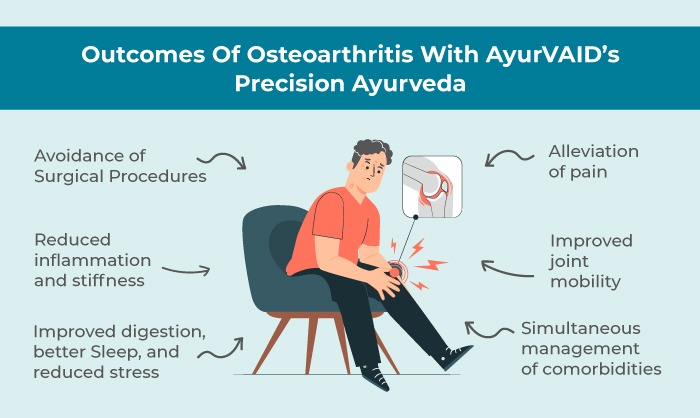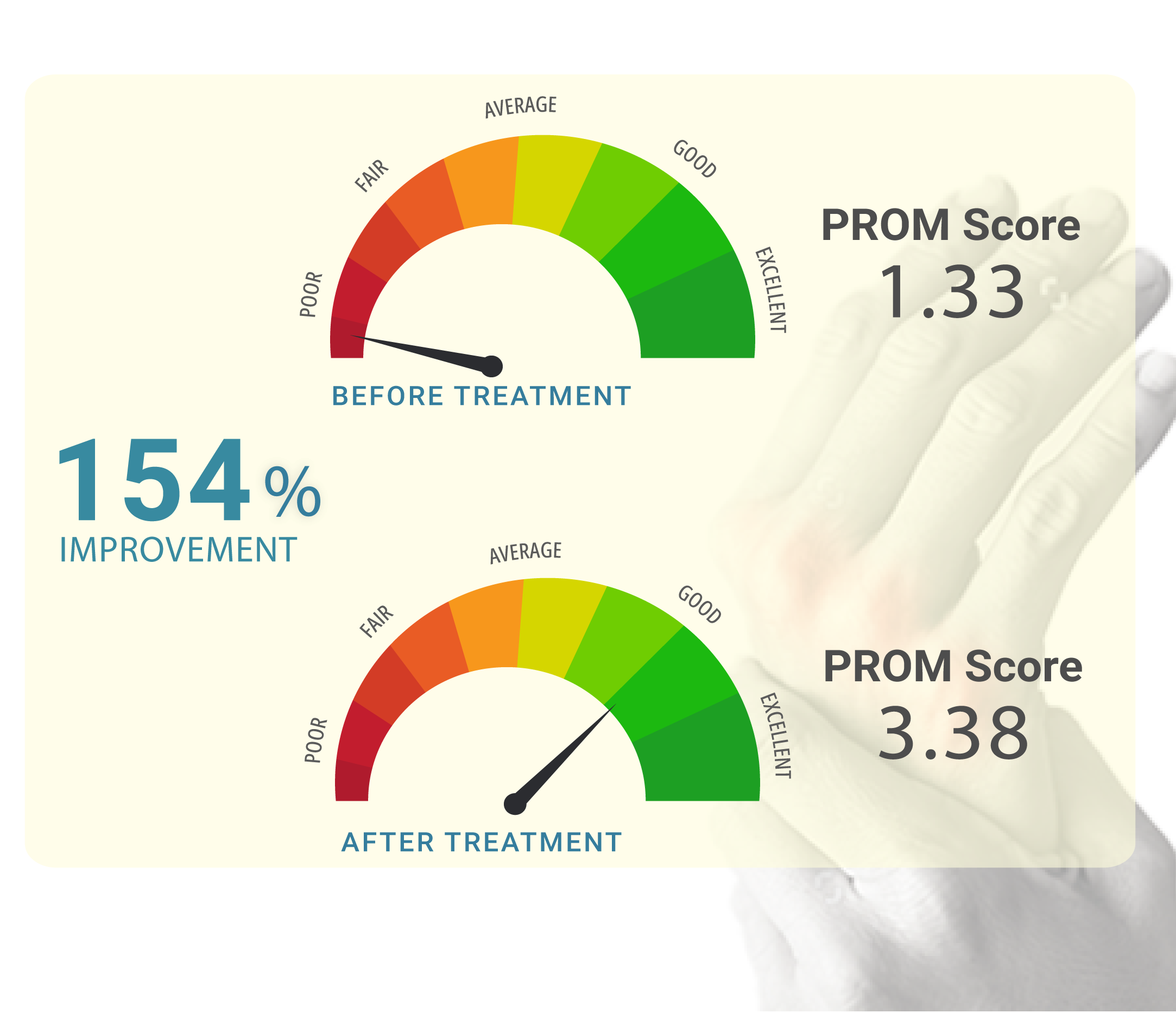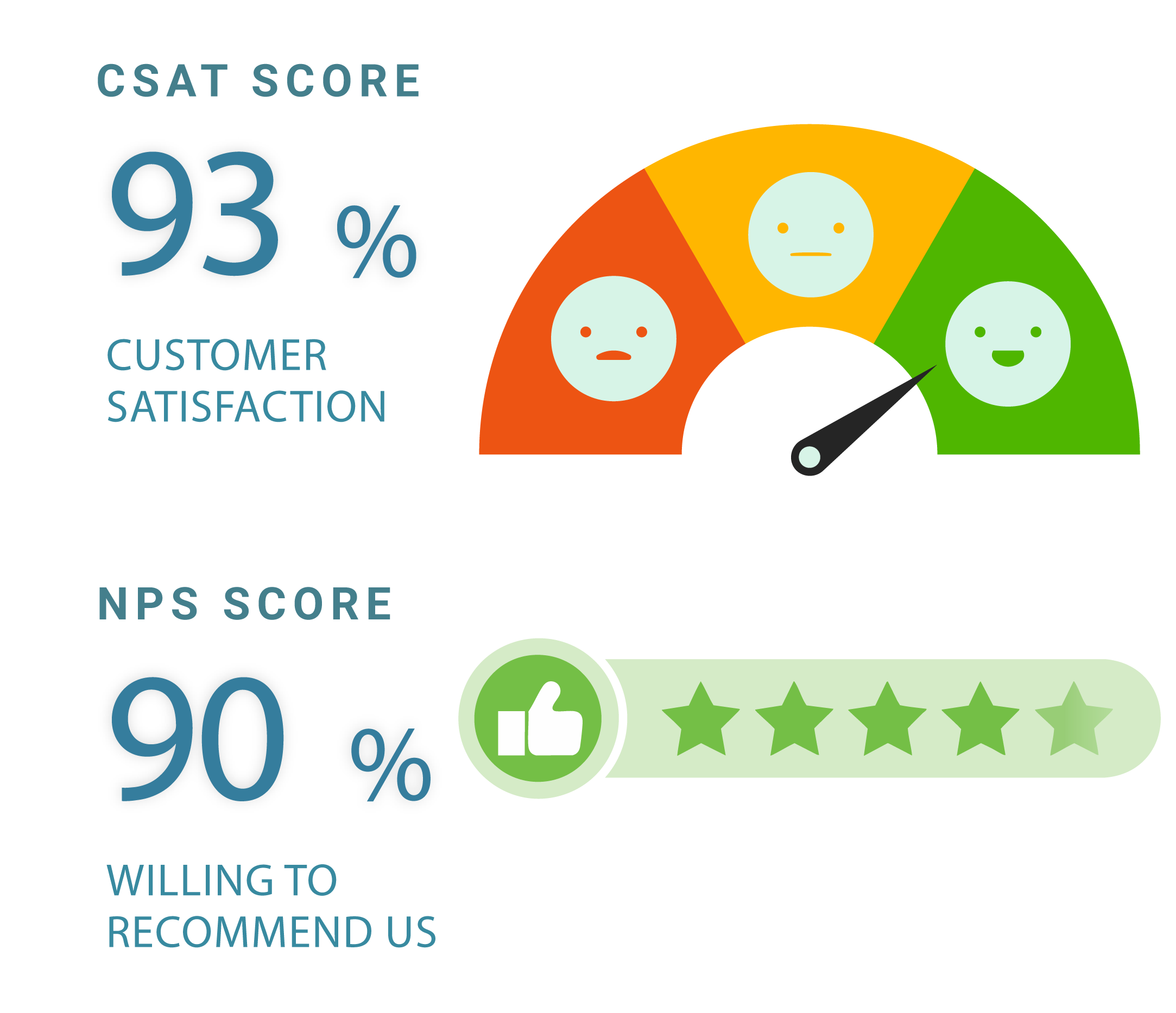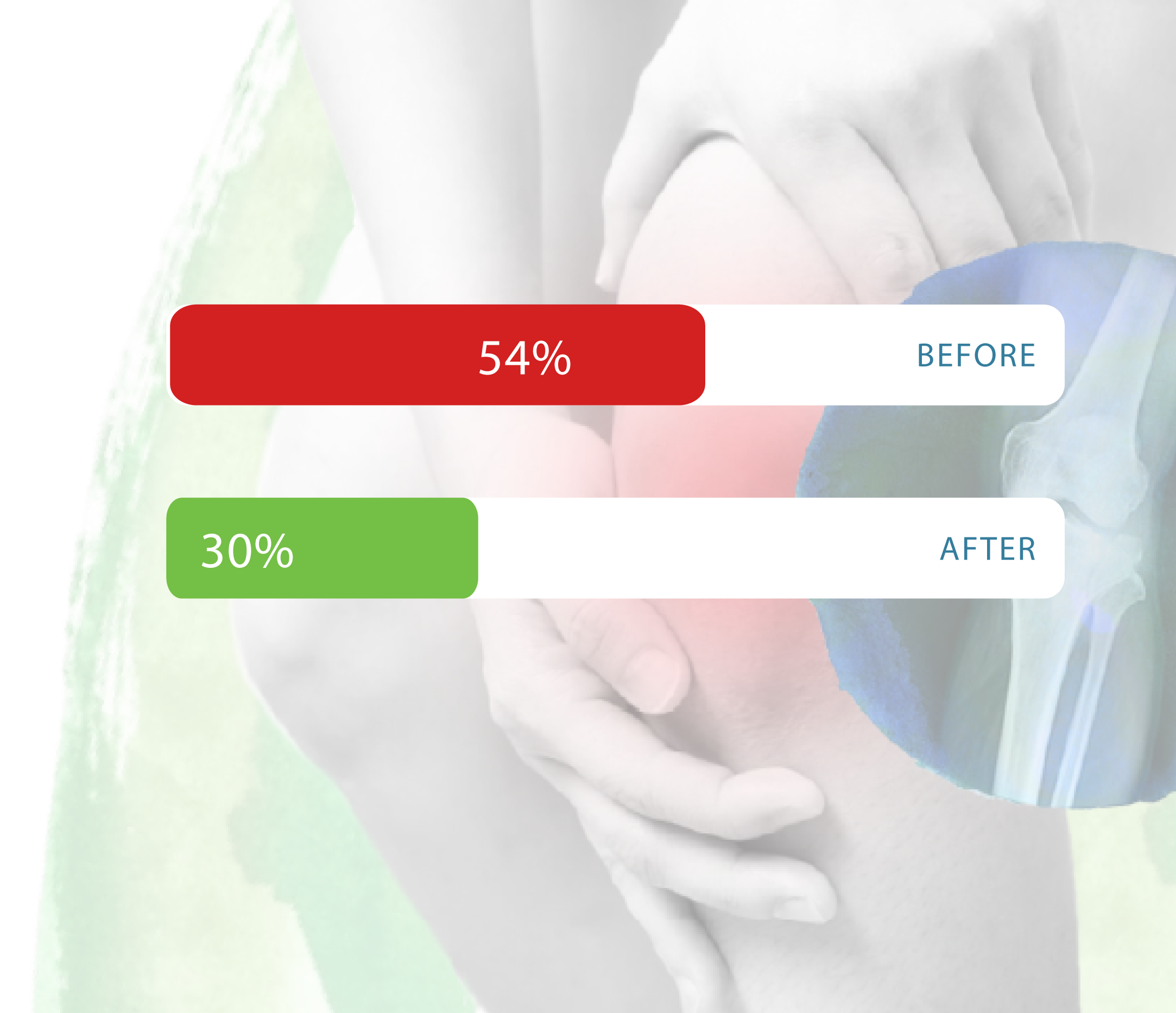- AyurVAID Pharmacy
In Ayurveda, Osteoarthritis is known as Sandhigata Vata (Sandhi=joint, Gatavata=imbalanced Vata getting dislocated in joints). It develops over time due to the degeneration of the protective cartilage at bone ends. It is characterised by pain, stiffness, swelling, and restricted movement in the affected joints.
Ayurveda attributes Osteoarthritis to Vata dosha imbalance with the depletion of Shleshak Kapha (synovial fluid). Factors like aging, obesity, inadequate diet, stress, or lifestyle disturb Vata, which thereafter afflicts the joints, producing dryness, stiffness, and pain.
Although Osteoarthritis can affect any joint, it is primarily seen in weight-bearing joints such as the knees, hips, and spine.
Apollo AyurVAID adopts an integrated, individual, and protocol-driven approach (Precision Ayurveda), addressing osteoarthritis’ root causes rather than treating only its symptoms.
A whole-person health assessment by an expert team of Ayurveda physicians is done to design a personalised protocol, comprising classical Ayurveda medications and therapies, targeted functional rehabilitation, and individualised diet and lifestyle modifications.Osteoarthritis knee – treatment in Ayurveda aims preventing disease progression, works towards restoring lost functionalities and reducing joint inflammation, which accelerates the healing process.
Arthritis surgical interventions can be prevented through this integrative and multidisciplinary approach.
While Ayurveda aims for root cause reversal for Osteoarthritis patients, the scope may be restricted to pain and symptom management in some cases, as below:


Modern medicine views Osteoarthritis as a disease of the joints characterised by the gradual degeneration of cartilage, the tissue cushioning the joint space. Symptoms include varying degrees of pain, stiffness, swelling, and a decreased ability to move. Osteoarthritis primarily affects weight-bearing joints like the knees, hips, and spine, and the risk factors include age, obesity, overuse of the joint, and genetic predisposition.
Conventional treatment methods focus on curtailing symptoms and improving joint function. These include:
With Osteoarthritis progression, the pain becomes more severe, and prolonged use of NSAIDs or corticosteroids often leads to side effects like gastrointestinal discomfort, cardiovascular risks, or dependence. Though effective, surgical treatment bears risks, costs, and a long recovery duration.
Conventional medicine offers a portion of immediate symptomatic relief and structural interventions, while osteoarthritis treatment in Ayurveda plays a massive role in the comprehensive management of Osteoarthritis. The patients, along with considerable pain and stiffness relief, improved mobility, and reduced inflammation and joint swelling, can expect the following unique benefits by way of the amalgamation of conventional therapies and intervention from Ayurveda:

The various physiological events involved in the disease development include the aggravation of Vata dosha and the depletion of Kapha dosha. Different dietary, lifestyle, and environmental factors may contribute to the imbalance of Vata dosha, which vary from person to person.
Dietary Factors ( Ahara ):Irregular eating patterns, imbalance in diet, timing, or quantity have an impact on metabolic dysfunctions, which over time is a key contributing factor for inflammation and progression of disease.
Lifestyle Factors ( Vihara):Erratic lifestyle patterns, including overexertion/ overuse of joints, can lead to progressive degradation. Further disturbed sleep patterns/day sleep, etc., can break the circadian rhythm, thereby increasing risk factors for Osteoarthritis. Further exposure to cold and dry climates for an extensive period can also build body imbalances.
Psychological Factors ( Manasika):In Ayurveda, the mind plays a significant role in many non-communicable diseases, including Osteoarthritis. Chronic stress, anxiety, grief, anger, etc., can lead to a build-up of ama (toxins) progressively.
Physiological Changes: Aging, hormonal differences, menopause, and hereditary factors also contribute to disease progression.


Pain worsens during movement or with pressure and often impacts regular activities such as walking, climbing stairs, or holding objects.
Puffiness or swelling around the affected joint, often feeling like a
bag filled with air.
A reduced range of motion leads to limited joint flexibility and mobility, which may be accompanied by stiffness, especially in the morning or after prolonged inactivity.
Imbalance of Vata Dosha:
The primary cause of Osteoarthritis is the aggravation of Vata dosha. Osteoarthritis is a gradual and progressive condition, often triggered by a continuous imbalance in diet, lifestyle, and poor environmental factors, as mentioned earlier.
Weakened Digestion:
Impaired digestion, or Agni Dushti, leads to the formation of Ama or toxins, which ultimately accumulate in the joints with an immune response that triggers and makes it inflamed.
Channel Obstruction:
Ama, or the waste products of metabolism, block the channels nourishing the bones, called Asthivaha Srotas, thereby obstructing the normal flow of nutrients and causing waste products to build within. This imbalance disrupts the body’s systems and leads to further complications.
Inflammatory Stages of Osteoarthritis:
At this stage, inflammation appears to be much more intense. The degenerative changes that take place in the tissues are accelerated, and warm or red areas appear around these, indicating the participation of Pitta dosha.
Depletion of Shleshaka Kapha:
An imbalance in Vata disrupts the Kapha dosha balance, mostly affecting Shleshaka Kapha, the natural lubricant of the joints. Thus, an increase in dryness with friction and a lowered cushioning level damages the structure of joints.
Bone Tissue Depletion (Dhatukshaya):
A lack of sufficient nutrient intake weakens bones and joints as the channels continue to be blocked.
Joint Inflammation and Damage:
The aggravated Vata lodges in the joints ( Sthana Samshraya) along with the weakened tissues ( Dosha-Dushya Sammurchhana). This leads to raised inflammation, degeneration of cartilage, destruction of bone, pain, swelling, and stiffness with lessened mobility.
While Osteoarthritis is primarily a Vata disorder, two distinct types of pathogenesis can occur:
Age-related Osteoarthritis (Tissue depletion-related Osteoarthritis): This type occurs in older age, when the Vata dosha dominance leads to the depletion of Sleshaka Kapha (joint lubrication) and impaired nourishment to tissues, leading to poor-quality tissue formation and joint weakness.
Obesity-induced Osteoarthritis (Obstruction-type Osteoarthritis): individuals, that is, those with excess body fat. The excess fat (Medas) obstructs the flow of nutrients to various tissues such as bones (Asthi) and marrow (Majja) and works toward the accumulation of toxins (Ama), thus causing depletion of tissue and obstructing the natural pathway of Vata Dosha in further ways.


The Apollo AyurVAID’s protocol-driven approach (Precision Ayurveda) for Osteoarthritis focuses on controlling symptoms, preventing their progression, minimising disability, and improving the quality of life.Osteoarthritis cure in Ayurveda is possible only in inital stage and depends on patient’s condition, comorbidity etc and external factors.
Ayurveda offers comprehensive treatment for arthritis, which harmonises the doshas, detoxifies the system, nourishes the joints, and sustains vitality. Treatment and duration are decided depending on the intensity of the disease.
Objective : This is the preparatory bodywork done to remove toxins and to balance excessdoshas. Acute symptoms like pain/stiffness are alleviated by reducing inflammation and the clearing of metabolic toxins (Ama) while enhancing digestion or digestive fire (Agni) as well.
Duration : Approximately 7 to 8 days
Treatment Protocol:
Internal Medicine: Ayurveda medicines are prescribed according to the dosha imbalance to promote digestive fire, thereby alleviating ama and bringing relief.
External Therapies: Lepa (herbal paste), Churna Pinda Sweda (medicated powder massage), and Kashaya or Dhanyamla Dhara (pouring of warm decoction) are done to reduce Ama, swelling, pain reduction, and inflammatory response alleviation.
Panchakarma Therapies
Objective: To cleanse the body of toxins and restore the balance of doshas.Duration: ~ 10-12 days
For Sthoola (Overweight) Patients:
Comorbidity Management: The management of obesity and diabetes or any other comorbidities (hormonal disorders), where they would directly influence the pathogenesis of Osteoarthritis, is addressed whenever required through dietary changes in conjunction with safe therapies such as Udwarthanam and Bashpaswedam.
Detoxification: It is initiated with Snehapana (internal oleation) and Virechana (therapeutic purgation) to eliminate toxins and mitigate aggravated Pitta dosha. Further, Yoga Vasti or Kala Vasti is done for Vata vitiation to reverse the disease pathways and to improve the strength of bone and bone marrow.
For Krisha(Lean) Patients: Abhyanga (oil therapy) lubricates joints, strengthens bones, and regenerates joint tissues. It is followed by
Yapana Vasti to reverse etiopathogenesis.
External Therapies: Therapies such as Pinda Swedam are done for all patients to rectify any residual issues and strengthen joints.
Diet: Warm, digestible foods are recommended.
These two steps are done under the surveillance of doctors on an inpatient basis.
Nourishing and External Therapies
Duration: 3-6 months
Nourishing Therapies: Local external therapies include Kati Basti, Janu Basti, Taila Dhara, and Ksheera Seka, which nourish and alleviate pain.
Rasayana Therapy: Lehyams, thailams, or gruthams help strengthen the joints and prevent degeneration, along with external therapies such as shashtika shali pinda sweda and ksheera sekam.
Lifestyle Changes: Includes dietary changes, yoga, light physical exertion, maintenance of body weight, and stress relief that aid in reviving joint health, halting disease progression, and preventing a recurrence (outpatient basis).
For the advanced Osteoarthritis Stage, the above approach is done for maintenance and slowing the progression, as etiopathogenesis reversal may not be possible.
NOTE: The duration of the treatment may vary depending on the stage of the disease, severity, and comorbidities involved.

AyurVAID follows a structured, protocol-driven approach to ensure effective treatment and sustainable recovery.
To ensure effective treatment and track progress, baseline values are taken using:
1. Based on 212 recent patients who took treatment across AyurVAID centers; The shared data is for representative purpose only; the actual outcomes may vary from patient to patient
2. WOMAC-Western Ontario and MacMaster Universities OA index – Standard Scale used to globally to assess the severity of OA
3. https://pmc.ncbi.nlm.nih.
gov/articles/PMC3283484/#F2
4. Based on a survey done with 50 random patients who took treatment with AyurVAID between 2019 and 2024


Case 1: A 58-year-old female patient with a 2-year history of severe osteoarthritis
Case Summary:
The patient presented with severe bilateral knee pain, multiple joint pain and stiffness, and restricted neck and shoulder movements, all significantly impacting her daily life.
The initial assessment revealed severely compromised mobility, an inability to perform basic tasks like writing and holding objects, disturbed sleep, and a poor appetite. X-rays showed wear and tear with bony growths (osteophytes) in both knees, but Inflammatory markers were normal.
The patient underwent an 18-day intensive Ayurvedic treatment (external therapies, internal medications, and specialized procedures). Post-treatment, pain levels were markedly reduced, functional improvements were noted, independence in daily activities was regained, and quality of life was improved with normalized appetite and improved sleep.
Case 2: A 54-year-old female patient with osteoarthritis symptoms for 2 yrs
Case Summary:
The patient presented with a two-year history of severe lower back pain and left-sided sciatica, along with bilateral knee pain, numbness in her left palm, and significant mobility restrictions.
Initial assessment revealed a restricted range of motion, high pain scores on the Visual Analogue Scale (VAS), limited activity tolerance for sitting, standing, and walking, and positive straight leg raise test results. MRI showed spinal issues.
The patient underwent a 16-day Ayurvedic treatment plan (therapies and internal medications). Post-treatment, near-complete resolution of pain and stiffness, a significant reduction in lower back pain, functional improvements, and improvements in stair climbing, kneeling, and squatting abilities were seen.

My pain has reduced by 50% after just 10 days of treatment! I am glad I chose Apollo AyurVAID for my treatment.”
Mr. R, Age- 62
World Health Organization. Osteoarthritis [Internet]. 2023 Nov 28. Available from:
![]()
Chandrol U, Nagpal S. Ayurvedic management of Sandhivata (Osteoarthritis). J Ayu Int Med Sci. 2023;8(12):236-240. Available from:
![]()
Kessler, C. S., et al. Effectiveness of an Ayurveda Treatment Approach in Knee Osteoarthritis – a Randomized Controlled Trial. Osteoarthritis and Cartilage, 26(5), 620–30, 2018.
![]()
Kessler, Christian S., et al. Ayurveda in Knee Osteoarthritis—Secondary Analyses of a Randomized Controlled Trial. J Clin Med. 2022;11(11):3047.
![]()
Singh, Balveer, et al. A Comprehensive Review Article on Sandhigatavata with Special Reference to Osteoarthritis. AYUSHDHARA, 2023:108–12.
![]()
Kumar, Pushpendra, et al. Integrative Approach in the Management of Janusandhivata w.s.r. to Osteoarthritis. Int J Ayurveda Pharma Res. Apr. 2022, 51–55.
![]()
Panda AK (2015). Ayurveda Treatment Outcomes for Osteoarthritis. J Homeop Ayurv Med 3: e115.
![]()
Ayurvedic Whole System Effective in Managing Rheumatoid Arthritis: Study.
![]()
Sharma S, Yalgachin G, Bhagat S. Pathya & Apathya in Sandhigata Vata: A Bird’s Eye View. Int J Health Sci Res. 2019; 9(6):309-314.
![]()
Gajendra Renuka. Concept of Different Samprapti of Sandhigata Vata. AYUSHDHARA, 2018;5(2):1648-1656.
![]()
Ritu Chaudhary, Anirban Singha, Preeti Gavali, J P Chaudhary, Kavita. A Critical Review on Importance of Samprapti with special reference to Sandhivata (Osteoarthritis). Ayushdhara, 2023;10:66-71.
![]()
Shah S, Mohite PA. A Literature Review of Osteoarthritis (Sandhigatavata) in Ayurveda. Int J Multidiscip Health Sci. 2022;8(1):32-38.
![]()
As we work hard to improve our services, your feedback is important to us. Please take a moment to help us serve you better.
The information provided in this blog is for general informational purposes only and is not intended as a substitute for professional medical advice, diagnosis, or treatment. Always seek the advice of your physician, Ayurvedic practitioner, or other qualified healthcare provider with any questions you may have regarding a medical condition or treatment.
Subscribe to our hospital newsletter for the latest health tips, updates on services, patient stories, and community events. Sign up today and stay informed!





Popular Searches: DiseasesTreatmentsDoctorsHospitalsWhole person careRefer a patientInsurance